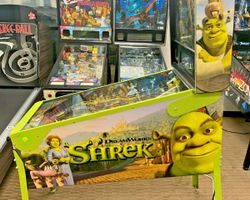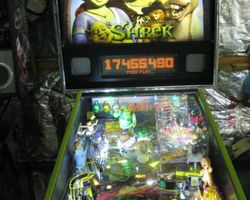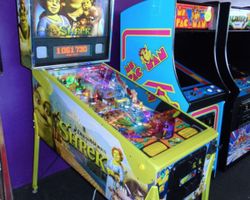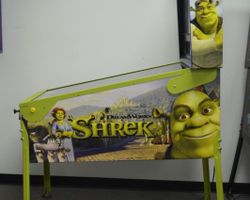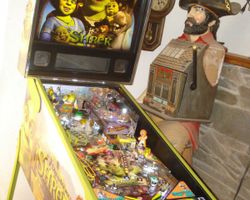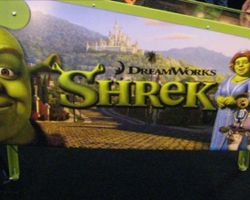Shrek™
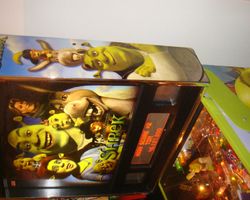
Average Prices: USD $2,900 to $5,600
Produced: 2008
Machine Type: Solid State Electronic
MPU: Stern S.A.M. Board System
Players: 4
Design by: Pat Lawlor
Art by: John Youssi
Dots/Animation by: Mark Galvez, Tom Kyzivat
Sound by: Jeff Powell
Software by: Lonnie D. Ropp, Mike Kyzivat
The pinball machine Shrek, released by Stern Pinball, Inc. in August 2008, draws its theme directly from the popular animated film franchise. This machine represents a notable strategy in pinball production: the re-theming of an existing design. Shrek effectively uses the playfield and core mechanics of Stern's Family Guy pinball machine, but with completely new artwork and software designed to immerse players in the fantastical world of Shrek, Fiona, and Donkey. Only 600 units of the Shrek pinball machine were produced, making it a less common title compared to many of Stern’s other releases.
The design team behind Shrek brought considerable experience to the project. Pat Lawlor, the original designer of the Family Guy playfield, contributed the foundational layout, which was then adapted for the Shrek universe. John Youssi provided the distinctive artwork, translating the animated film’s visual style to the pinball playfield and cabinet. On the software side, Lonnie D. Ropp and Mike Kyzivat crafted the game's programming, ensuring thematic integration and unique gameplay modes. The sound design, handled by David Thiel and Jeff Powell, was a complex undertaking. Powell recounted the intricate process of sourcing and editing audio, including a blend of "lifted" movie dialogue and custom speech. A significant hurdle involved securing approval from major actors like Mike Myers and Eddie Murphy for sound-alike voice actors, an eleventh-hour effort for Stern Pinball. Licensing the Smash Mouth song "All Star" for the game's opening music also presented challenges, ultimately leading to the original recording for the intro and a custom instrumental version for general main play. The remainder of the music was meticulously looped from the Shrek movie soundtracks, a demanding task given the orchestral nature of the original scores. This intricate sound production alone extended the project timeline considerably.
Signature Features and Design
The Shrek pinball machine features several standout elements that define its character and enhance the player experience. Central to its unique appeal is the "Donkey Pinball" mini-playfield, a distinct elevated section that houses its own miniature pinball for players to control. This multi-leveled playfield element creates a varied shot experience, offering a diversion from the main playfield action. Visually, the machine captures the vibrant and whimsical aesthetic of the Shrek films. John Youssi's artwork covers the playfield, cabinet, and backglass, presenting beloved characters such as Shrek, Fiona, Donkey, Puss-in-Boots, and Gingy. The cabinet itself often features a striking lime green chrome finish, immediately linking it to the titular ogre. Beyond the visuals, the machine integrates custom speech callouts featuring sound-alikes of the film's characters, providing humorous and thematic commentary throughout gameplay. The five flippers on the playfield, including a crucial third flipper, expand shot opportunities and add to the machine's complexity.
Playfield and Mechanics
The Shrek playfield, while sharing its fundamental layout with Family Guy, is visually transformed. The primary objective is to engage with the characters and elements of the Shrek universe. The layout includes two main ramps, offering satisfying shots that direct the ball to upper playfield areas. Three pop bumpers, strategically placed, contribute to random ball movement and increase scoring opportunities. The machine features a variety of targets: a four-bank of drop targets, nine standup targets, and a solitary drop target, all contributing to mode progression and point accumulation. Interactive toys include two captive balls and two Newton balls, which can be repeatedly hit for points or to activate features. A spinning target also adds a dynamic element to the playfield.
The most notable mechanical feature is the "Donkey Pinball" mini-playfield, an elevated area accessible from a specific shot on the main playfield. Players activate a mini-flipper to control a small pinball within this self-contained space, aiming for specific targets or scoring goals. An up-post positioned between the main flippers provides a ball-save mechanism or a strategic hold point. The playfield's artwork is rich with details and vivid colors, reflecting the fantastical swamps and castles from the movies. Lighting is integrated to guide players to active shots and emphasize mode progression, contributing to a cohesive and immersive aesthetic. The design philosophy encourages players to explore different sections of the playfield, engaging various targets and ramps to advance through the game's objectives.
Gameplay Dynamics
Gameplay on Shrek revolves around progressing through modes based on the film's narrative and characters, ultimately aiming for the multi-ball and wizard modes. The machine supports a five-ball multi-ball, a high-scoring opportunity where multiple pinballs are in play simultaneously, encouraging rapid target hitting and combo building. To initiate multi-ball or advance through modes, players typically need to hit specific targets or sequences of shots associated with characters like Shrek, Fiona, Donkey, or Puss-in-Boots. The game's rule set allows for strategic stacking of modes, where players can activate several objectives before initiating a multi-ball, leading to exponentially higher scores.
A unique challenge and significant gameplay element is the "Donkey Pinball" mini-playfield. Activating this allows players to switch to controlling a mini-flipper and aim for specific objectives within that small, self-contained area, often tied to advancing the main game's modes or earning bonus points. While a significant scoring opportunity, the wizard mode in Shrek is widely considered to be an exceptionally difficult achievement, requiring a comprehensive understanding and mastery of the game's various objectives. Players might focus on repeatedly hitting the ramps for consistent scoring or working towards completing character-specific objectives. The game offers a range of challenges, from precision shots to chaotic multi-ball action, catering to different play styles.
Reception and Legacy
The Shrek pinball machine has garnered a mixed yet generally positive reception within the pinball community. Its strengths often cited include engaging gameplay that is accessible to both casual players and pinball enthusiasts, particularly families. The "Donkey Pinball" mini-playfield frequently earns praise as a distinctive and enjoyable feature that sets the machine apart. Many appreciate its good shot flow and potential for combos, offering a satisfying variety of targets and ramps. The theme implementation is also a strong point, with vibrant artwork and well-integrated elements from the Shrek movies. The custom callouts, especially those mimicking Donkey, are often highlighted for their humor and thematic contribution. The inclusion of "All Star" by Smash Mouth for the opening music is also generally well-received. Its relatively low production number of 600 units contributes to its status as a sought-after collectible.
However, certain aspects of Shrek have drawn criticism. Some players find the "Donkey Pinball" mini-playfield to be a gimmick or, at times, overly chaotic, feeling it detracts from the main playfield's flow. For some, the game can become repetitive over extended play, particularly concerning the sound package if one is not a devoted fan of the movies. The layout, being a re-theme, is considered by some to be unusual or to limit the overall flow compared to other designs. Specific shots can be challenging to execute consistently. The game’s initial ball launch is sometimes noted as awkward. Despite its strengths, some veteran players find it does not quite stand on par with other titles from different manufacturers. Its legacy lies in being a niche, family-friendly Stern title, demonstrating the company's approach to leveraging popular licenses with existing proven layouts. Its distinctive multi-level playfield and the detailed sound production story contribute to its place in pinball history, showcasing the unique challenges and creative solutions involved in bringing licensed properties to the silverball experience.
Sponsored Links
 Ebay Listings
Ebay Listings
 Auction Results
Auction Results
| Cost | Location | Date |
|---|---|---|
| USD $6,195 |  Illinois, United States Illinois, United States |
04 May, 2024 |
| USD $4,600 |  California, United States California, United States |
18 April, 2024 |
| USD $6,500 |  Florida, United States Florida, United States |
18 January, 2023 |
| USD $8,500 |  Michigan, United States Michigan, United States |
07 November, 2021 |
| USD $7,995 |  Nevada, United States Nevada, United States |
29 August, 2021 |
| GBP £3,500 |  Barnet, United Kingdom Barnet, United Kingdom |
24 December, 2020 |
| USD $4,000 |  North Carolina, United States North Carolina, United States |
22 January, 2019 |
| USD $4,250 |  Utah, United States Utah, United States |
18 December, 2018 |
| USD $3,850 |  New York, United States New York, United States |
05 December, 2018 |
| GBP £3,750 |  United Kingdom United Kingdom |
22 August, 2018 |


Private Policy · Search Website · Contact Us
As an eBay Partner, we may earn a commission from qualifying purchases made through links on this site, at no additional cost to you.
All trademarks and copyrighted materials remain property of their respective owners. All other content copyright 2007 - 2026 Pinpedia.

